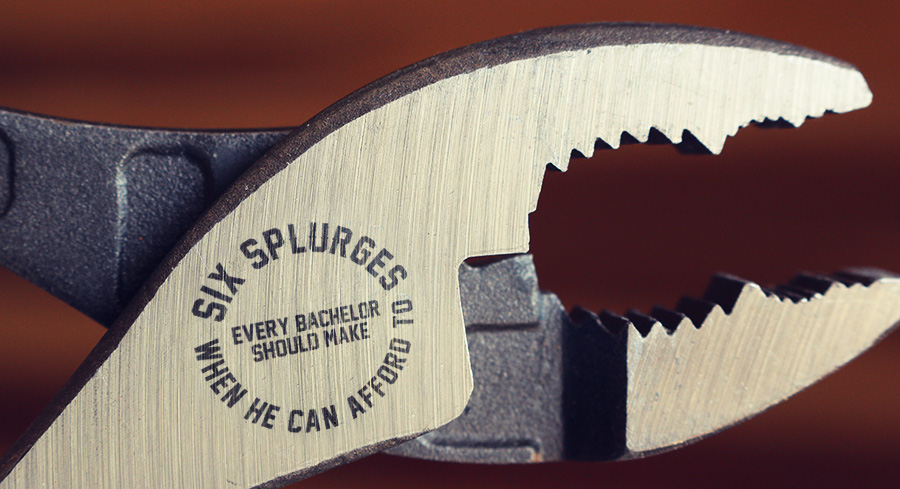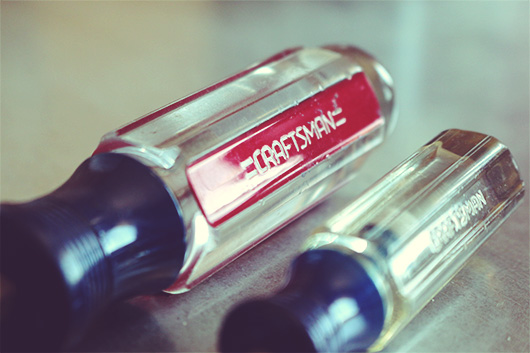Saving money is great, and not overpaying for your things or buying more than you need are good habits to start building early. But in certain situations you’re better off spending a little more up front to buy the absolute best you can afford. In the olden days, everything was made to last. I eat breakfast on the same kitchen table my grandparents as young parents served breakfast to my father and his siblings on in their Brooklyn apartment. That was sixty years ago, and it’s not much worse for the wear. Since then, the very nature of our society’s relationship with possessions has changed to the point where low-cost, essentially disposable versions of everyday items like furniture and cookware are in high demand and available just about everywhere.
While it may seem counter-intuitive to suggest splurging if you’re working with a modest budget, these upgrades aren’t necessarily intended to be all made at once, and I’m in no way suggesting taking on debt to make these purchases. Keep in mind that not all big purchases are created equal. A financial advisor would probably never suggest you buy a $10,000 pair of dress shoes, but a $200-300 pair, bought once and worn in undiminishing comfort and style for years, is a sounder investment than a series of inexpensive dress shoes bought more frequently. Sometimes quality really counts, and can be had for a lot less than you’d expect. You will without a doubt know where the extra money went every time you use the following items if you buy the best you can afford, when you can afford it.
Your bed.
Expect to pay: $1,000
If you’re fortunate enough to sleep 8 hours a night, you'll spend one-third of your life in your bed. How well and how comfortably you sleep can impact your health and overall well being in many ways. Cheap mattresses bow, pop springs or squeak. When it comes to size (twin, full, queen, king, etc.), go for the pricier, smaller one over the cheaper, larger one. For example, always get a $1,200 queen-size mattress over a king-size mattress of the same price. The bed might be a little smaller than you had planned, but you will notice the quality difference every single night. And so will your back. Most mattresses are made to last 8-10 years. Dropping a grand or so on a well-made, supportive mattress is well worth the up-front investment. Look at it as renting nightly comfort for $100 a year. Who’s going to argue with that?
Plus, if you’re a good negotiator you can usually snag a good deal. Mattresses are often marked 20 to 30 percent or more above what they’re willing to let them walk out the door for.
Your Shoes.
Expect to pay: $160-$300
Your shoes put up with a lot. They have the important and thankless task of supporting your weight all day long and making sure you don't step on pointy stuff. Of course, inexpensive footwear has a welcome place in many fashionable men’s wardrobes, so we’re talking about the essentials here: a nice pair of wing tips, a solid pair of boots, etc. Spending more on a few select pairs of footwear now will actually save you money in the long run. Check the math. Why spend a year or two wishing you had spent a little more when you can splurge a bit on something better that will last three, four, or five times longer? You may, at first blush, bristle at the $300 price tag on these Allen Edmonds Strands, but what you are paying for is quality that will far outlast even multiple pairs of $50-$60 shoes.
Quality shoes can also be re-soled and recrafted to like-new conditions many times over the course of their lives. Something cheaper shoes can’t do.
Towels.
Expect to pay: $10-$30
For many bachelors, towels kind of just “happen.” You never really know where they came from; you sort of acquire them over the years. Some of them have been rendered nearly transparent, pulling double duty as occasional bath mats and enduring hundreds of washes. If you haven’t before, check out the price range on towels some day. It might surprise you to learn you can spend as little as $3-$4 or as much as $30 and up on a single towel. Unless money is no object or you’re the proprietor of a high-end spa, you don’t need to spend anywhere near the $30 side of the scale, but the quality improves dramatically if you go a few tiers up from the dirt-cheapest towels they’ve got at the store. Spending a bit more here will be something you notice on a daily basis. Cheap towels tend to pill, come apart after a few wash cycles or leave you covered with lint.
A nice towel will be luxurious, make you feel enveloped, and be covered in thirsty little bristles. The key differentiator is absorption–cheap towels can just push the water around on your body. You won’t believe the difference between a $10 towel and a $3 towel. And don’t forget to pick up an extra set for when you have guests over.
Cookware.
Expect to pay: $30-$50 (individually), $130-$300 (set)
Now, you might not be a gourmet chef. Hopefully you’ve been paying attention and have gotten some decent recipes under your belt by now, but at any level, an artist is only as good as his tools. That said, upgrading your pots and pans isn’t cheap, but it’s another place where spending a little more up front will save money in the long run, as quality cookware is made to stand the test of time. Avoid cheap non-stick pans with sprayed-on, potentially toxic coating that in time becomes scratched to hell and comes off the surface, unless you like your pancakes with chemicals.
Go for aluminum or steel. Even if you just start out with a frying pan and a pot and gradually add to your collection over time, quality-made pots and pans purchased in your 20s should be around to cook your future children laser eggs, or whatever kids will be eating by then.
Another good option for the arsenal is a nice hefty piece of cast iron cookware. Cast iron pans are cheaper than other materials and can perform certain tasks better than other cookware, like searing and sauteing meat. Pots and pans also make a good gift ask for birthdays and holidays. Just make sure the gift-giver explicitly knows you’re looking to upgrade your gear, not add another tin $10 supermarket special to the scrap heap.
Whole sets of kitchen and steak knives from reliable brands can be found online for $60 and often much less, including a nice wooden butcher block, and these knives will outperform and outlast the cheaper ones every time.
Hand tools.
Expect to pay: $12-$75
There’s something to be said about the satisfaction derived from watching your very own toolbox evolve over time into a lean, mean, fixing machine. It’s a proud day when you’ve built it up to the point where you find you’re equipped to handle most everyday household fix-it problems with ease. And building up a proper set of tools doesn’t have to break the bank. First, stick to the basics. You probably aren’t Tim “The Tool Man” Taylor, so a simple, quality set of basic hand tools should be more than adequate to start you in the right direction. Shop around for deals and coupons online. Hardware stores love having sales around holidays, so take advantage. You could also score macho points with the significant other if you ask for a tool or two as a gift. Some brands like Craftsman also have lifetime warranties, so you’ll never have to worry about being hammerless at an inopportune time.
Select furniture pieces.
Expect to pay: $75+
If you’re just starting out, chances are you haven’t acquired a home full of quality furniture yet. There’s no shame in furnishing your space heavily with IKEA, but if there’s room in your budget for a statement piece or two, you can find something that will really tie a room together.
What those statement pieces consist of depends solely on your needs. You wouldn’t buy a mahogany 8-seat dining table for a 4th floor walk-up studio apartment, but a nice leather chair, an ottoman, or even a mini bar could add some dramatic aesthetic flair to an otherwise budget-conscious decor. These pieces will be pricier than the particleboard stuff, but they’ll be built to last. IKEA furniture, once assembled, isn’t really meant to be moved around very much, and has a tendency of falling apart when you try to. These inexpensive items have their place, but a high-quality piece of furniture will maintain structural integrity for the long haul (or the U-Haul.)
So gents, I implore you: Resist the Siren’s song of the $10 frying pan. Do not be lulled into a false sense of thrift by a $200 mattress. They will not be made to last, and before too long will have to be replaced. And since the concept of “high-end” is entirely relative and in the eye of the beholder, you may be surprised how luxurious some of these upgrades can feel–especially if you’re used to always going with the cheapest acceptable option.





















